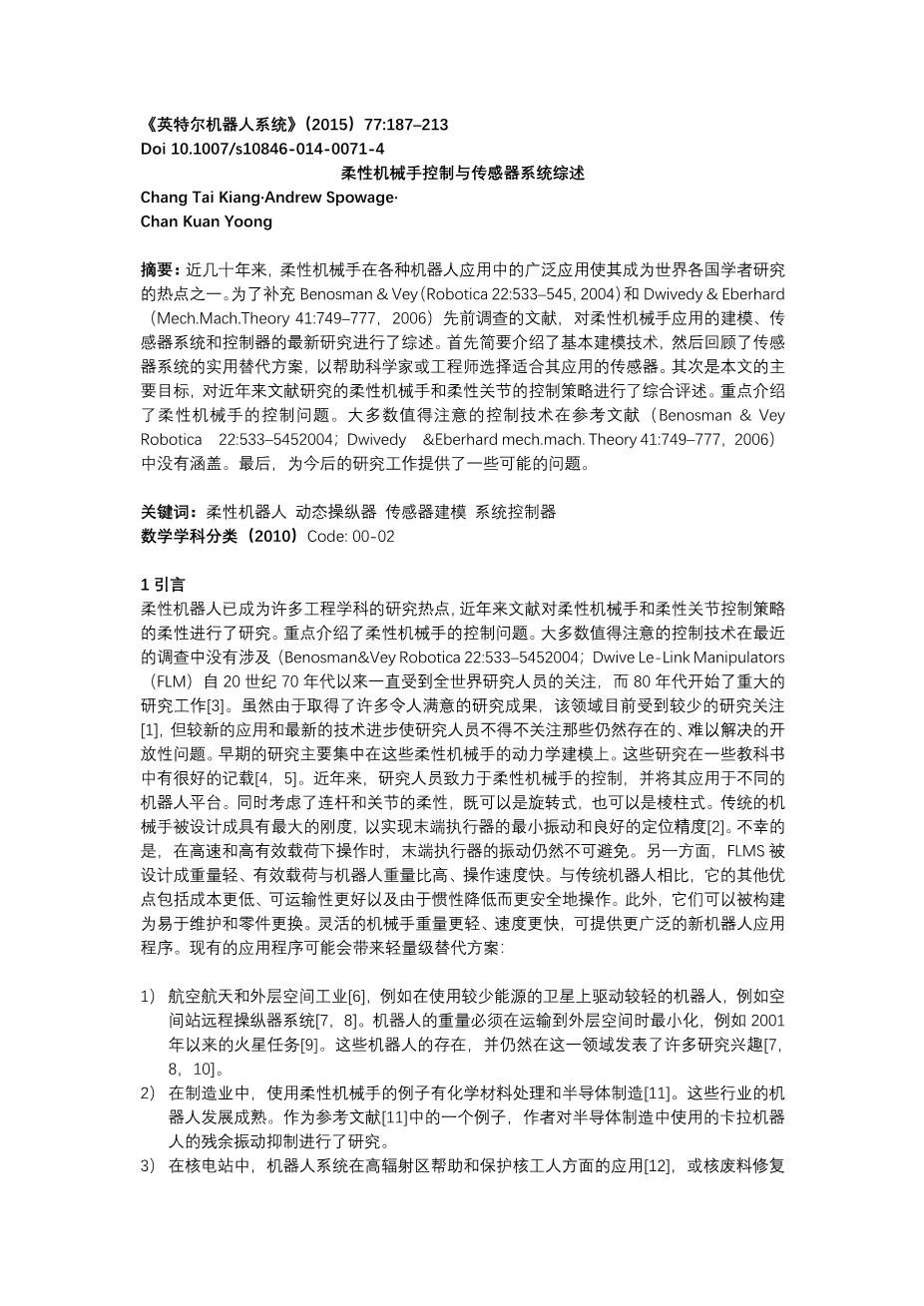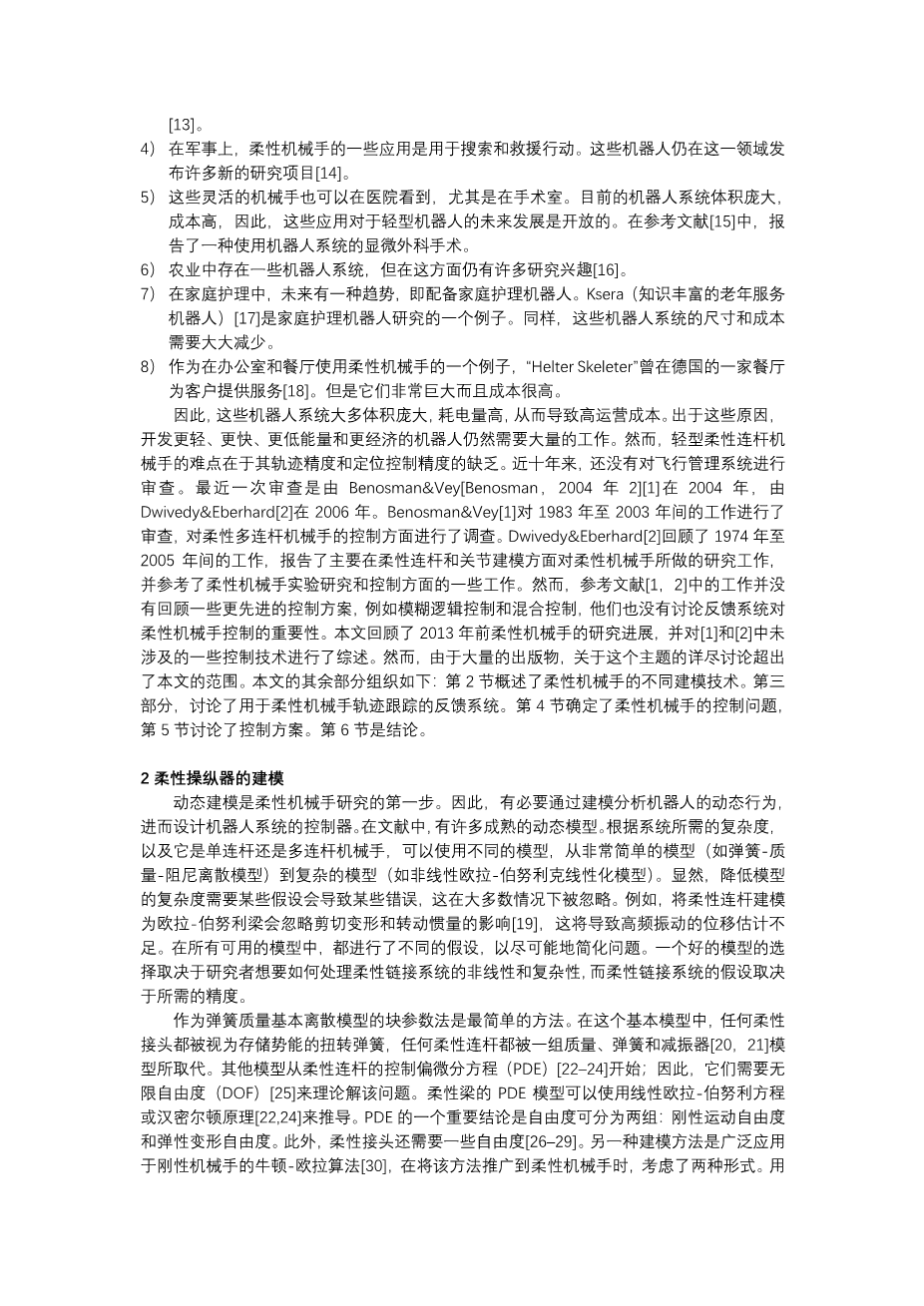Review of Control and Sensor System of Flexible Manipulator
Abstract Over the last few decades, extensive use of flexible manipulators in various robotic applications has made it as one of the research interests for many scholars over the world. Recent studies on the modeling, sensor systems and controllers for the applications of flexible robotic manipulators are reviewed in order to complement the previous literature surveyed by Benosman amp; Vey (Robotica 22:533–545, 2004)and Dwivedy amp; Eberhard (Mech. Mach. Theory 41:749–777, 2006). A brief introduction of the essential modeling techniques is first presented, followed by a review of the practical alternatives of sensor systems that can help scientists or engineers to choose the appropriate sensors for their applications. It followed by the main goal of this paper with a comprehensive review of the control strategies for the flexible manipulators and flexible joints that were studied in recent literatures. The issues for controlling flexible manipulators are highlighted. Most of the noteworthy control techniques that were not covered in the recent surveys in references (Benosman amp; Vey Robotica 22:533– 545,2004;Dwivedyamp;EberhardMech.Mach.Theory 41:749–777, 2006) are then reviewed. It concludes by providing some possible issues for future research works.
Keywords Flexible robotic manipulators·Dynamic modeling·Sensor systems·Controllers Mathematics Subject Classification (2010) Code: 00-02
1 Introduction
Flexible robots have been of research interests across many engineering disciplines, and the study of flexible link manipulators (FLM) are of on-going research interest for researchers worldwide since the 1970rsquo;s, while 1980rsquo;s began major research efforts [3]. Although this research area has received lesser research attentions now due to many satisfactory results obtained [1], but newer applications and latest technological advancements made researchers to attend to those remaining open problems which were too complex to solve. Earlier studies were mainly focused on the dynamic modeling of these flexible manipulators. Those studies were documented very well in some text books [4, 5]. Recently, researchers have focused on the controlling of the flexible manipulator as well as applying them onto different robotic platforms. Both link and joint flexibility were considered, which can be either revolute or prismatic manipulators.
Conventional robotic manipulators have been designed to have maximum stiffness so as to achieve minimum vibration and good positioning accuracy of the end-effector[2].Consequently, bulky design using heavy materials and high power drives are required for these types of robots. Unfortunately, vibrations of the end-effector are still unavoidable when operating at high speed and high payloads. On the other hand, FLMs are designed to be lightweight, higher payload-to-robot-weight ratio, and higher operational speed. Other advantages over conventional robots include lower cost, better transportability and safer operation due to reduced inertia. Furthermore, they can be built to be easy to maintain and part replacements. Being lighter and faster, flexible manipulators offer wider and newer robotics applications. There are existing applications that pose potential for lightweight alternatives:
1) The aerospace and outer space industries [6], such as driving lighter robots in satellites using lesser energy, for example the space station remote manipulator system [7, 8]. Weights of the robots have to be minimized while transporting into outer space, such as the Mars mission since 2001 [9]. These robots exist and are still posting many research interests in this area [7, 8, 10].
2) In the manufacturing industries, the examples of using flexible manipulator are chemical material handling and semiconductor manufacturing [11]. Robots in these industries are maturely developed. As an example in Ref. [11], the author conducted a research on residual vibration suppression of SCARA robots used in semiconductor manufacturing.
3) In nuclear plants, the applications of robotic systems to help and protect nuclear workers at high radiation areas [12],or nuclear waste remediation [13].
4) In Military, some applications of flexible manipulator are for search and rescue operations. These robots are still posting many newer research projects in this area [14].
5) These flexible manipulators can be seen in hospitals as well, especially in the operation rooms. Current robotic systems are bulky and high-cost, thus, these applications are open for future development of light-weight robots. In Ref. [15], a micro surgical operation using robotic system was reported.
6) There exist some robotic systems used in agriculture, but, are still posting many research interests in this area [16].
7) In homecare; there is a future trend having homecare robot for elderly. KSERA (Knowledgeable Service Robots for Aging) [17] is an example of the research on homecare robot. Again, the size and cost of these robotic systems needs to reduce considerably.
8) As an example of using flexible manipulators in offices and restaurants, the “helter-skelter” used to serve customers at a restaurant in Germany [18]. But they are very huge and very high-cost.
Whence, these robotic systems are mostly bulky and high power consuming, resulting in high operating cost. For these reasons, much works are still needed to develop lighter, faster, lower energy and more economical robots. However, the very challenging problems of the light-weight flexible link robotic manipulators are the lack of accuracy in trajectory and positioning control. The review of FLMs has not been presented for near to one decade. The most recent review was by Benosman amp; Vey [Benosman, 2004 #2][1] in 2004 and by


英语原文共 7 页
资料编号:[5461]
以上是毕业论文外文翻译,课题毕业论文、任务书、文献综述、开题报告、程序设计、图纸设计等资料可联系客服协助查找。


